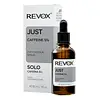What's inside
What's inside
 Key Ingredients
Key Ingredients

 Benefits
Benefits

 Concerns
Concerns

 Ingredients Side-by-side
Ingredients Side-by-side

Water
Skin ConditioningCaffeine
Skin ConditioningNiacinamide
SmoothingButylene Glycol
HumectantGlycerin
HumectantDimethyl Sulfone
SolventSodium Hyaluronate
HumectantPyridoxine Hcl
Skin ConditioningCamellia Sinensis Leaf Extract
AntimicrobialHamamelis Virginiana Leaf Extract
Skin ConditioningPanax Ginseng Root Extract
EmollientEpigallocatechin Gallate
AntioxidantPolysorbate 20
EmulsifyingCarbomer
Emulsion StabilisingEthylhexylglycerin
Skin ConditioningPhenoxyethanol
PreservativeSodium Benzoate
MaskingSodium Hydroxide
BufferingCitric Acid
BufferingWater, Caffeine, Niacinamide, Butylene Glycol, Glycerin, Dimethyl Sulfone, Sodium Hyaluronate, Pyridoxine Hcl, Camellia Sinensis Leaf Extract, Hamamelis Virginiana Leaf Extract, Panax Ginseng Root Extract, Epigallocatechin Gallate, Polysorbate 20, Carbomer, Ethylhexylglycerin, Phenoxyethanol, Sodium Benzoate, Sodium Hydroxide, Citric Acid
 Reviews
Reviews

Ingredients Explained
These ingredients are found in both products.
Ingredients higher up in an ingredient list are typically present in a larger amount.
Caffeine is most associated with coffee, tea, and cacao. In skincare, it helps with calming inflammation and is rich in antioxidants.
While caffeine is used to treat cellulite and and dark circles, further studies are needed to prove this. It has been believed to help with these skin conditions due to its ability to dilate blood vessels and increase blood flow.
Some studies are looking into caffeine's ability to protect against UV rays.
Learn more about CaffeineCamellia Sinensis Leaf Extract is derived from the leaves of the tea plant. Black tea, green tea, and oolong tea are all harvested from this plant.
This ingredient has many skin benefits:
This ingredient contains polyphenols, a strong antioxidant. Antioxidants help fight off molecules that damage skin cells.
On top of that, the antioxidants in green tea neutralize free-radicals from the sun. This gives the skin some extra UV protection, but should not replace sunscreen.
Many components of tea have anti-inflammatory properties.
Polyphenols and L-theanine help soothe the skin and reduce irritation. The caffeine in Camellia Sinensis Leaf Extract helps calm inflamed blood vessels.
Other compounds found in tea include: Vitamin Bs, linoleic acid, magnesium, calcium, iron, and zinc.
Research has shown both drinking Camellia Sinensis Leaf Tea and applying it to the skin can help boost skin elasticity and hydration. Studies also show using tea extract may reduce sebum, or oil, production.
Learn more about Camellia Sinensis Leaf ExtractPhenoxyethanol is a preservative that has germicide, antimicrobial, and aromatic properties. Studies show that phenoxyethanol can prevent microbial growth. By itself, it has a scent that is similar to that of a rose.
It's often used in formulations along with Caprylyl Glycol to preserve the shelf life of products.
Water. It's the most common cosmetic ingredient of all. You'll usually see it at the top of ingredient lists, meaning that it makes up the largest part of the product.
So why is it so popular? Water most often acts as a solvent - this means that it helps dissolve other ingredients into the formulation.
You'll also recognize water as that liquid we all need to stay alive. If you see this, drink a glass of water. Stay hydrated!
Learn more about Water